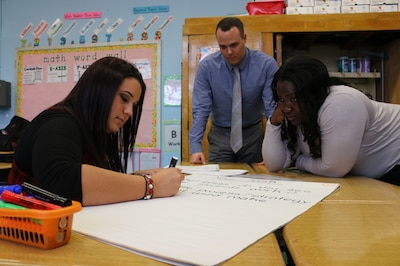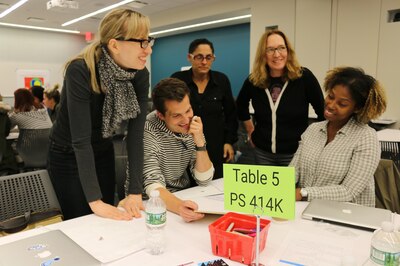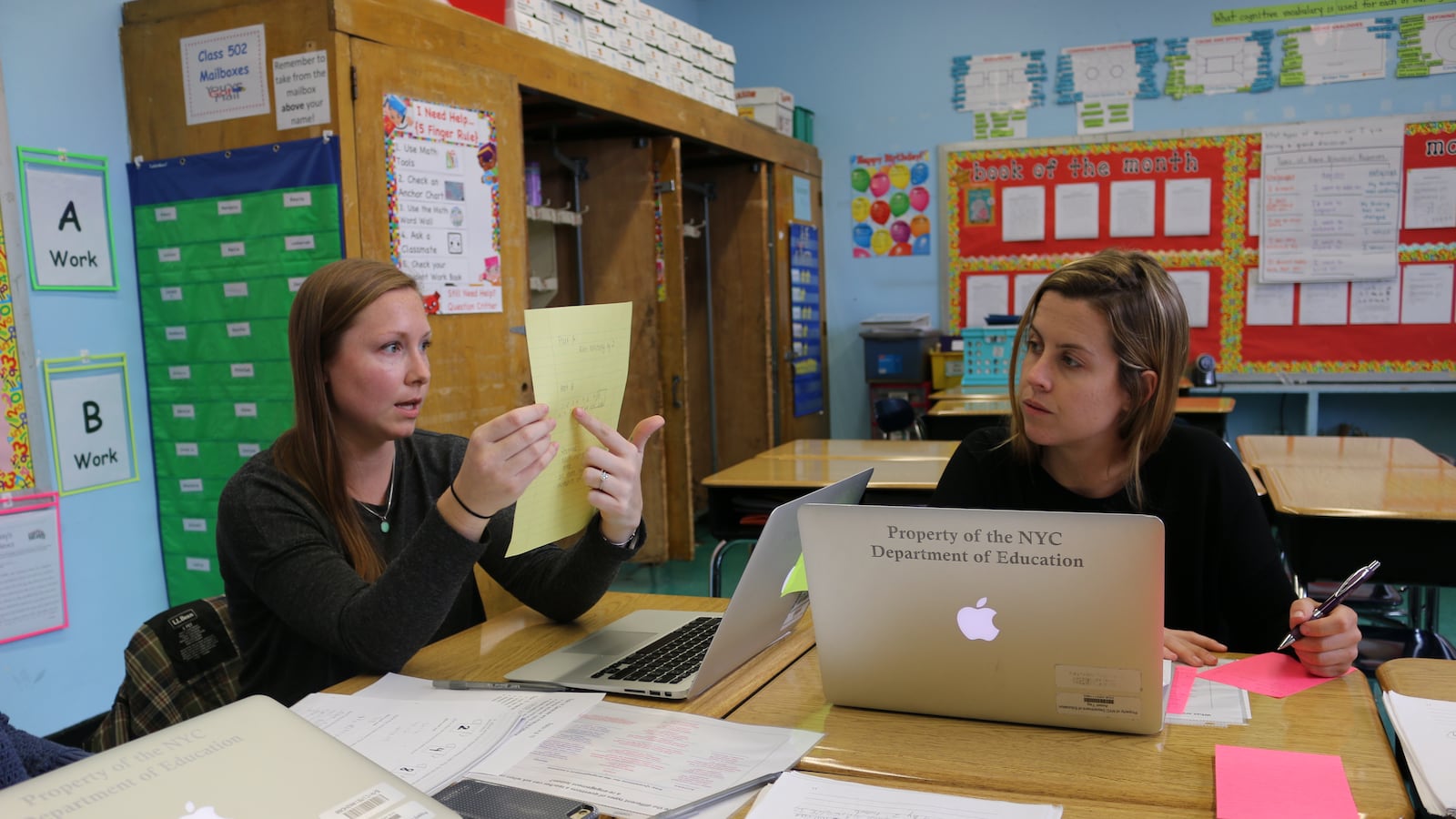It was a Monday afternoon and school was out at P.S. 294. But there was plenty of learning happening inside the blue-and-yellow building in the Bronx.
Teams of teachers were gathered in classrooms on almost every floor. One group discussed a recent math lesson on how to identify patterns; another analyzed which questions had stumped students during recent statewide tests. A third was thinking about new ways to encourage discussion in the classroom.
In each huddle, they were learning a valuable lesson from each other: how to become better teachers.
What’s happening at P.S. 294 is what Carmen Fariña envisioned when she became chancellor of the country’s largest school system. Among the veteran educator’s most deeply held beliefs is that school improvement starts in the classroom — by helping teachers get better at teaching.
“To me, everything that happens in the classroom is the most crucial thing in the building,” Fariña told Chalkbeat.
Many of Fariña’s reforms reflect that vision, including the city’s contract with the teachers union, which carves out time for professional development each week. But another set of changes Fariña made — overhauling the education department bureaucracy — has sometimes worked at cross purposes, taking power away from those who know schools best.
Strapped superintendents and staffers sidelined in support centers now oversee much of the training teachers encounter. Fariña herself acknowledges it has sometimes been a struggle to meet the diverse needs of schools under the new system.
One Bronx principal said he sees that struggle firsthand.
“What some people call ‘supporting instruction with professional development,’ other people would call ‘bloated bureaucracy,’” the principal told Chalkbeat. “I have no interest in their professional development, and they don’t know my school.”
***
Like much of what has happened at the education department under Mayor Bill de Blasio, the chancellor’s emphasis on teaching the teachers marks a radical shift from the preceding administration.
Former Mayor Michael Bloomberg and Chancellor Joel Klein wanted great teachers in every classroom, too. But their position was that it was easier to hire top talent than cultivate it. Instead of pouring resources into teacher improvement, they set about measuring teachers to weed out those who were ineffective.
“Joel didn’t believe in professional development at all,” said Eric Nadelstern, who served as deputy chancellor for school support and instruction under Klein. “His question was, ‘Is it easier to change the teacher — or to change the teacher?’” Klein himself did not agree to be interviewed for this story.
When Fariña took the helm, educators took heart that one of them was in charge again. With 50 years of experience in New York City classrooms, she was the first chancellor in more than a decade who didn’t need a waiver, which the state requires when a school leader does not have the experience set by law for the job.
“When de Blasio named Fariña chancellor, it was a message,” said Norm Fruchter, a researcher at New York University who previously served as a de Blasio appointee to the Panel for Educational Policy. “The pendulum was going to shift back towards valuing instruction.”
In one of her first moves as chancellor, Fariña helped hammer out a contract with the United Federation of Teachers, the union that had clashed for years with Bloomberg and Klein. Among its most significant changes: giving teachers 80 minutes after school every Monday to work on improving their craft. The contract also created new leadership positions that gave extra pay to skilled teachers who agreed to take on coaching roles in their schools.
Taken together, those moves helped create a structure for helping teachers improve within their own schools.
“The thing with the most value in schools is time,” said Phil Weinberg, deputy chancellor of the department’s Division of Teaching and Learning. “The biggest thing that we’ve done is to honor the fact that learning has to happen by creating time.”
Share your thoughts on the quality of New York’s professional development for educators in our short survey.
***
In the education world, there is much debate around whether professional learning really works. Plenty of research suggests that typical models do not. Educators have their own disparaging vocabulary to describe those models: drop-and-go, spray-and-pray, even drive-by professional development. The idea is that one-off lectures and workshops are rarely effective in changing teacher practice, let alone improving how much students are learning.
However, recent research suggests there are ways to get it right. A review of 35 different studies, released in June by the Learning Policy Institute, found common themes in professional learning programs that actually improve student performance. Those programs provide coaching, are collaborative and typically happen on the job — much like what’s happening at P.S. 294.
P.S. 294 The Walton Avenue School serves students who are traditionally among the city’s lowest-performing — those who are homeless, learning English, or have disabilities. Yet it outperforms the city average on standardized tests.

The school has taken on Algebra for All, a de Blasio initiative that helps schools change the way they teach math. P.S. 294 also has teacher leaders paid to share their knowledge with teams of their colleagues. Those teams then work together in the 80 minutes each week reserved for professional development. All of that comes together under a principal, Daniel Russo, who makes sure teachers get the feedback they need to improve their practice.
“We come back every couple of months and say, ‘How are we doing on this? What fell by the wayside and what are ways that we can do better?’” Russo said. “Everyone is going to contribute to, and benefit from, the greater knowledge that there is in the room.”
For all its ambitions, the 80 minutes don’t always work as planned. In about a dozen interviews with teachers and principals, many school staff said they appreciate that the Monday sessions have provided time and space to think about their practice. But others said that time can feel wasted or forced.
“Everyone is very busy at our school, and that’s just another meeting that has to take place to plan more meetings,” a Bronx high school teacher told Chalkbeat. (The teacher, like many educators interviewed for this story, agreed to speak only on the condition of anonymity.)
“A lot of times we’re not really sure what we’re going to do on a given day,” the teacher said. ”It’s not very focused throughout the year.”
***
Why, then, are some schools making good use of the new training time and at others, teachers feel like it’s being frittered away?
One factor: changes to the way principals are supervised and how schools get support.
Under Bloomberg and Klein, principals who needed help turned to dozens of “networks” scattered throughout the city. Principals opted into networks based on their schools’ needs, regardless of where the school or network were located in the city. The network providers were expected to solve problems for schools, or principals could vote with their feet and join different networks.
"That’s the system-wide idea of support now: taking people away from kids."
David Baiz, former principal of Global Technology Preparatory
As chancellor, Fariña took a different approach. She promptly rebuilt the department’s Division of Teaching and Learning, which had been dissolved after she left the DOE in 2007. Once again, there was an office at the Department of Education’s central headquarters dedicated to actively helping schools decide what and how to teach.
She also empowered superintendents, calling them the “instructional leaders” of their districts, and upped the years of experience required to land the job. They evaluate principals but are also responsible for making sure schools get the support they need.
In the place of networks, Fariña opened “field support centers,” which serve hundreds of schools but don’t hold supervisory power. Unlike networks, most centers only work with schools located in the same borough. Superintendents and support centers are expected to work together to help schools improve teaching.
Crucially, that doesn’t always happen. The result can work against the 80 minutes, by distancing decision-making about professional development from schools — and complicating it, too.
Our principal is “held with her hands behind her back,” said Corey Taylor, a music teacher at P.S. 33 in the Bronx. “She has to do what she’s being told by her higher-ups.”
Now, principals are expected to ask their superintendents for help, who then turn to field support centers. Some principals and support centers do work directly together, though Weinberg said that’s not the preferred system.
“The ideal thing is that you’re in constant conversation with your superintendent,” he said. “It would be hard for each borough field support center to hear 145 different requests every day, from each of their schools.”

Relationships between superintendents and support centers don’t always run smoothly, and both are tasked with overseeing many schools. Superintendents have staffs of around six people, yet may be responsible for dozens of schools. Support centers work with up to 323 schools, with an average caseload just below 200.
With superintendents acting as a filter between schools and support centers, many principals report a divide between what they’re offered and what they want to learn.
“There’s a disconnect between the reality of what’s going on in classrooms, and the offerings,” one Manhattan principal told Chalkbeat. “It usually comes down to: Teachers need to learn, very specifically, techniques, tips, philosophies that affect their own practice.”
When they work well, support centers might send staff to a school to provide targeted help requested by its principal. But, faced with heavy caseloads, the centers often respond to schools’ needs by creating borough-wide professional development sessions that can vary in quality. In the city’s most recent survey of principals, only 73 percent said they were satisfied with the support they get from the centers.
One Manhattan teacher said she went to sessions offered by the support center last year and was disappointed with what she found. The presenters led a lesson on “guided reading,” a technique that includes introducing vocabulary and breaking students into groups, but they seemed fuzzy on how to execute the practice in the classroom.
“Teachers were actually correcting them,” the teacher said. “They’re removed and they forget what it’s like to be a teacher.”
***
Despite Fariña’s emphasis on classroom-based learning, many of the support centers’ professional development sessions are happening outside schools, while class is in session. At three separate support centers, almost all the trainings for teachers offered during the month of May were held during school hours.
"We’ve set aside the time. We’ve set up the space. Can we just manage it?"
Michael Mulgrew, president of the teachers union
That wouldn’t have happened under Bloomberg, according to Nadelstern, the former Klein deputy. He said his policy was that teachers and principals should not be pulled away from schools while students are in the building.
“That’s the system-wide idea of support now: taking people away from kids,” said David Baiz, the former principal of Global Technology Preparatory in East Harlem. “That’s not really the best way that adults learn: to sit in a meeting away from the context of their work environment and then try to come back and incorporate it.”
In addition to out-of-office professional development, superintendents host monthly meetings, pulling principals out of their schools for the entire day. In some cases, they include meals paid for by vendors who present professional development sessions based on educational products they’re selling.
“There’s just this feeling among almost every principal that I know,” a Bronx principal told Chalkbeat. “Like meeting after meeting after meeting and requirement after requirement are being added, and really drowning out the time needed for real collaboration.”
In an interview with Chalkbeat, Fariña admitted that professional development run by outside vendors is “not that effective.” She also acknowledged there have been growing pains as the superintendents and field support centers try to meet the needs of all the schools they serve.
“It’s been more of a struggle in some places where there was a more diverse need,” she said.
To address that, Fariña said the centers have been working on “modules” based on different areas of need. A module may highlight effective strategies for teaching students who are learning English, for instance, and come with a series of professional development courses that can be run over a period of multiple weeks.
“Each principal can adapt it as they see fit,” Fariña said.
***
Weinberg said it is easy, in a system as large as New York City, to point to “random” weak points.
“What our real goal is, is continuous improvement,” he said. “I think that we make mistakes, oftentimes, by looking at one anecdotal example as a way of disproving a larger movement.”
Michael Mulgrew, president of the teachers union, said the department needs to pay closer attention to how schools are using the resources that are now available. While the the 80 minutes of professional development time is a game-changer, he said, it can also vary in usefulness depending on school culture, principal leadership and how well superintendents and the field support centers can provide help.
“We’ve set aside the time. We’ve set up the space. Can we just manage it?” Mulgrew said. “The fact that the chancellor made this a priority when she came in is the reason why you see the school system moving forward. My fear is, have we reached a plateau?”
It may be tricky, however, to balance the kind of oversight that Mulgrew envisions with the personalization that teachers and principals say is necessary for effective professional development. But the city is evaluating its own work to make sure it’s hitting the mark for teachers and schools.
“Teaching is really fascinating and difficult work,” Weinberg said. “We need to approach this hard job with the humility that says we have the ability to learn more — and we want to learn more.”
Chalkbeat reporters Monica Disare and Alex Zimmerman contributed to this report.

